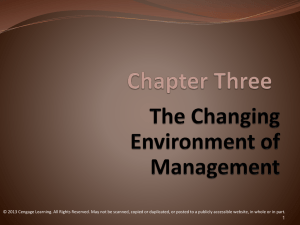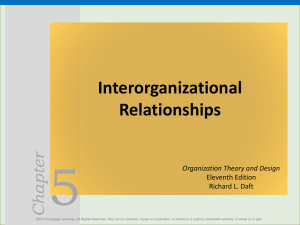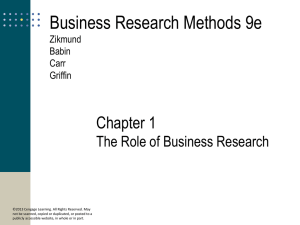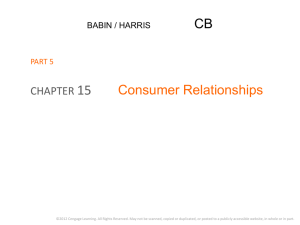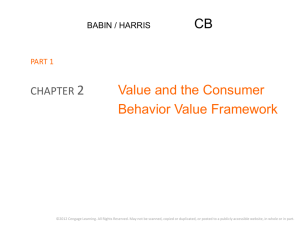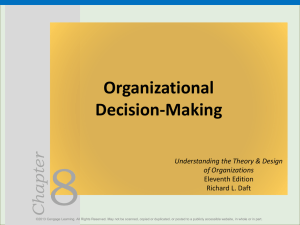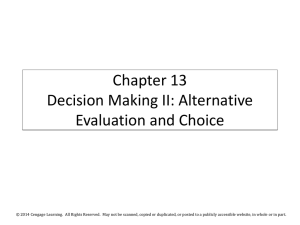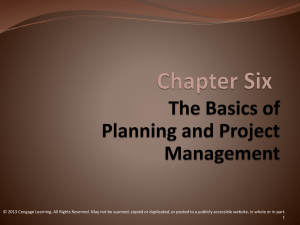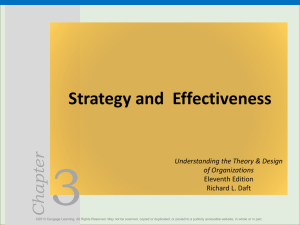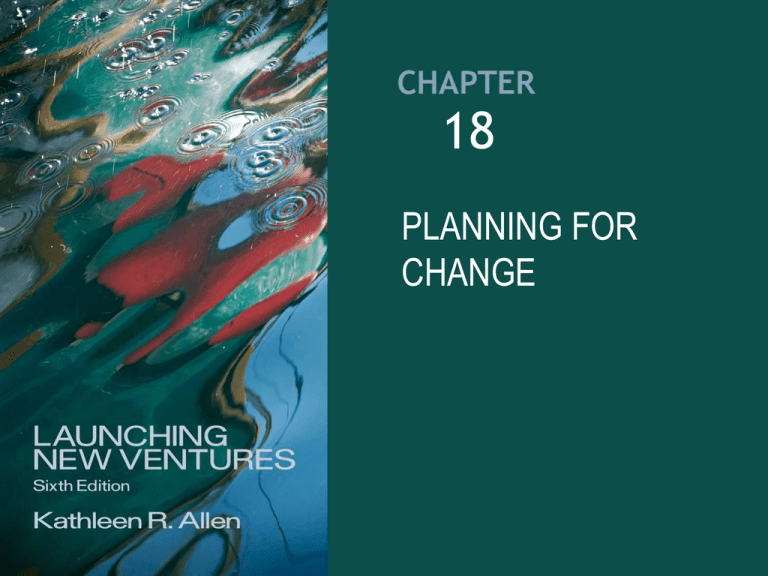
18
PLANNING FOR
CHANGE
©2012 Cengage Learning. All Rights Reserved. May not be scanned, copied or duplicated, or posted to a publicly accessible website, in whole or in part.
Learning Objectives
Discuss the role of risk management in the
entrepreneur’s growth planning.
Explain the various risks that affect startups during
early growth.
Discuss the importance of succession planning for
entrepreneurs.
Discuss the various ways that entrepreneurs can
exit and harvest the wealth created by the
business.
Describe the role of bankruptcy in business failure.
©2012 Cengage Learning. All Rights Reserved. May not be scanned, copied or duplicated, or posted to a publicly accessible website, in whole or in part.
Preparing for Contingencies:
Risk Management
Risk: when future events occur with
measurable probability
Uncertainty: when the likelihood of certain
events is unknown, indefinite, incalculable
©2012 Cengage Learning. All Rights Reserved. May not be scanned, copied or duplicated, or posted to a publicly accessible website, in whole or in part.
Preparing for Contingencies:
Risk Management (cont’d)
Effective contingency plans answer the following
questions:
1. In event of problem, which suppliers will extend
entrepreneur’s repayment line?
2. What nonessential assets can be sold for cash
quickly?
3. Can additional investment capital be tapped?
4. Are customers willing to repay or purchase earlier
than planned?
5. Has a good relationship with banker and accountant
been established?
©2012 Cengage Learning. All Rights Reserved. May not be scanned, copied or duplicated, or posted to a publicly accessible website, in whole or in part.
Figure 18.1
Managing Risk in a New Venture
©2012 Cengage Learning. All Rights Reserved. May not be scanned, copied or duplicated, or posted to a publicly accessible website, in whole or in part.
Identifying Potential Risks
Process improvement strategies to reduce the
probability of risk through alliances
Buffer strategies to protect against potential risk
that can’t be prevented
Types of risks:
•
•
•
•
•
•
Supply chain risks
Taxes and regulations
Intellectual piracy
Product liability
Cyber risk
Decline in sales
©2012 Cengage Learning. All Rights Reserved. May not be scanned, copied or duplicated, or posted to a publicly accessible website, in whole or in part.
Calculating Risk Probability
and Cost to the Business
Risk of Loss = (P x C x S)
P = Probability of occurrence
C = Cost to the business
S = Level of significance of impact
©2012 Cengage Learning. All Rights Reserved. May not be scanned, copied or duplicated, or posted to a publicly accessible website, in whole or in part.
Leadership Succession
Succession planning: identifying people
who can take over key company positions
in an emergency or in a change of
ownership
• External hires
• Promoting from within
©2012 Cengage Learning. All Rights Reserved. May not be scanned, copied or duplicated, or posted to a publicly accessible website, in whole or in part.
Change of Ownership in Small
Enterprises
Simple process for succession planning:
1.
2.
3.
4.
Situation assessment
Announcement of the process
Execution of the search
Transition
Consider “key person” insurance
Consultants may be hired
Cross-training is important
©2012 Cengage Learning. All Rights Reserved. May not be scanned, copied or duplicated, or posted to a publicly accessible website, in whole or in part.
Succession Planning in FamilyOwned Business
Issues that require time to work out:
• Physiological and emotional issues that stem
from the interrelations of family members
• The complexity of succession, particularly
since the owner typically has no experience in
this area
• Relevant laws and taxation that impact the
financial status of the company
©2012 Cengage Learning. All Rights Reserved. May not be scanned, copied or duplicated, or posted to a publicly accessible website, in whole or in part.
Succession Planning in FamilyOwned Business (cont’d)
Questions to ask:
1. Is the next generation being sufficiently
prepared to take over the business when the
time comes?
2. What is the second generation’s expectation
for the future of the business, and is it
congruent with the company’s vision?
3. What skills and experience does the second
generation need to acquire?
4. What would the ideal succession plan look
like?
©2012 Cengage Learning. All Rights Reserved. May not be scanned, copied or duplicated, or posted to a publicly accessible website, in whole or in part.
Planning for Harvest and Exit
Types of entrepreneurial career paths:
•
•
•
•
Growth entrepreneurs
Habitual entrepreneurs
Harvest entrepreneurs
Spiral, or helical, entrepreneurs
©2012 Cengage Learning. All Rights Reserved. May not be scanned, copied or duplicated, or posted to a publicly accessible website, in whole or in part.
Planning for Harvest and Exit
Selling the business
• To another company or an individual
Cashing out but staying in
• A phased sale
• Employee Stock Ownership Plan (ESOP)
©2012 Cengage Learning. All Rights Reserved. May not be scanned, copied or duplicated, or posted to a publicly accessible website, in whole or in part.
Figure 18.2
Restructuring the Family Business
©2012 Cengage Learning. All Rights Reserved. May not be scanned, copied or duplicated, or posted to a publicly accessible website, in whole or in part.
Dealing with Failure:
Bankruptcy
Various reasons for bankruptcy but
common denominator is poor
management.
Chapter 11: reorganizes the business so it
can continue operating and paying its debt
Chapter 7
• An Order for Relief
• It liquidates the assets and discharges most
types of debt
©2012 Cengage Learning. All Rights Reserved. May not be scanned, copied or duplicated, or posted to a publicly accessible website, in whole or in part.
Chapter 7
Advice for making a bad situation better:
• Entrepreneurs should talk to other entrepreneurs who
have been in similar situations.
• End a business before it affects the entrepreneur’s
personal life.
• A business owner should never commingle
personal/business funds.
• Do not ignore the government.
• Begin looking for opportunity.
• Pay back investors first.
©2012 Cengage Learning. All Rights Reserved. May not be scanned, copied or duplicated, or posted to a publicly accessible website, in whole or in part.
Final Thoughts
Entrepreneurship is:
• A mindset
• A way of viewing the world
• A skill set that can be learned
Who should be an entrepreneur?
• Anyone who wants to experience the freedom
and independence that comes from knowing
that opportunities and resources to make
those opportunities a reality are within their
grasp!
©2012 Cengage Learning. All Rights Reserved. May not be scanned, copied or duplicated, or posted to a publicly accessible website, in whole or in part.
New Venture Action Plan
Identify the risks that could affect the
business at various points in the future.
Develop a contingency plan for all the
high-probability/high-impact scenarios
that may affect the business in the future.
Set goals for the business that will enable
the appropriate exit or harvest strategy.
©2012 Cengage Learning. All Rights Reserved. May not be scanned, copied or duplicated, or posted to a publicly accessible website, in whole or in part.



